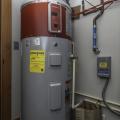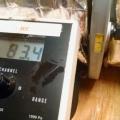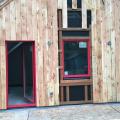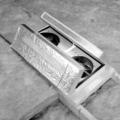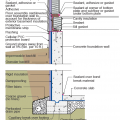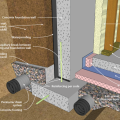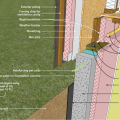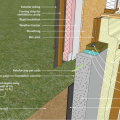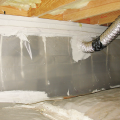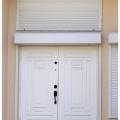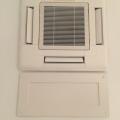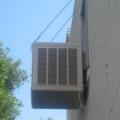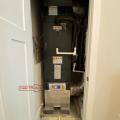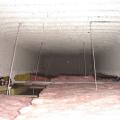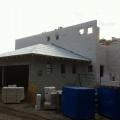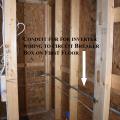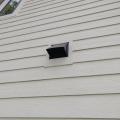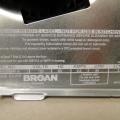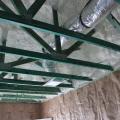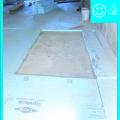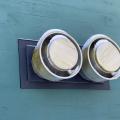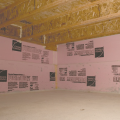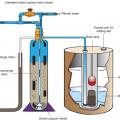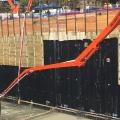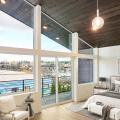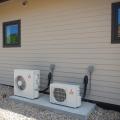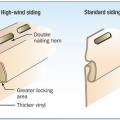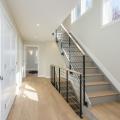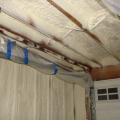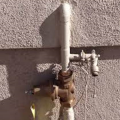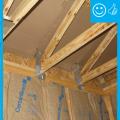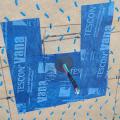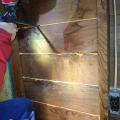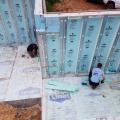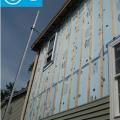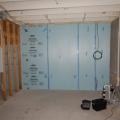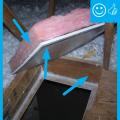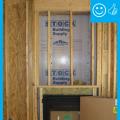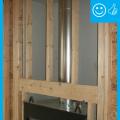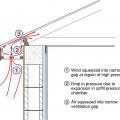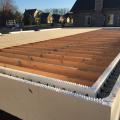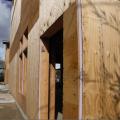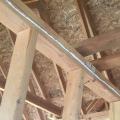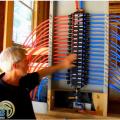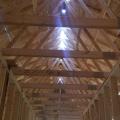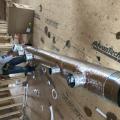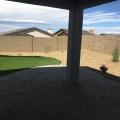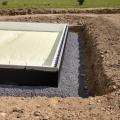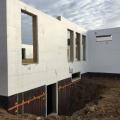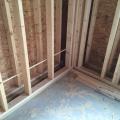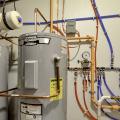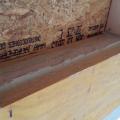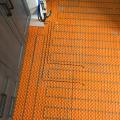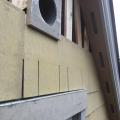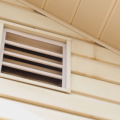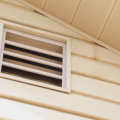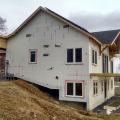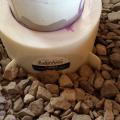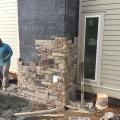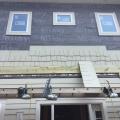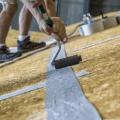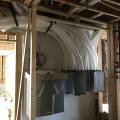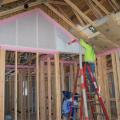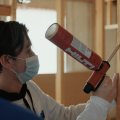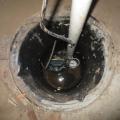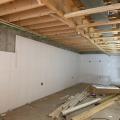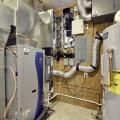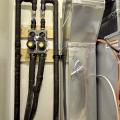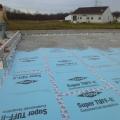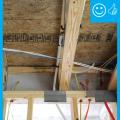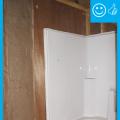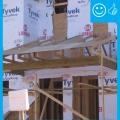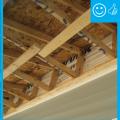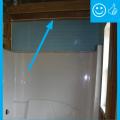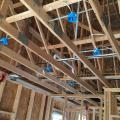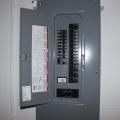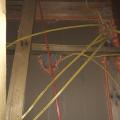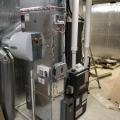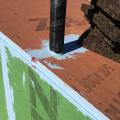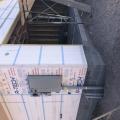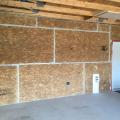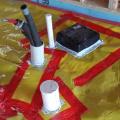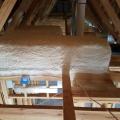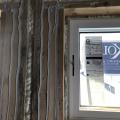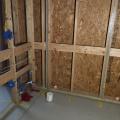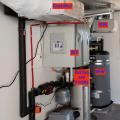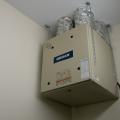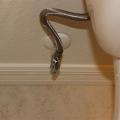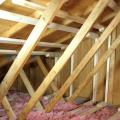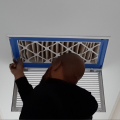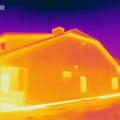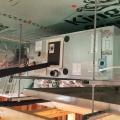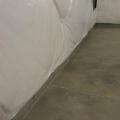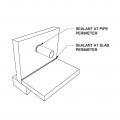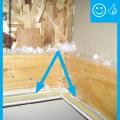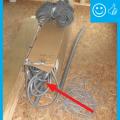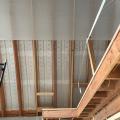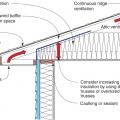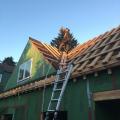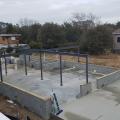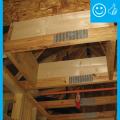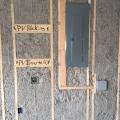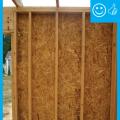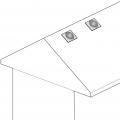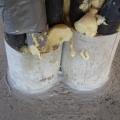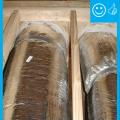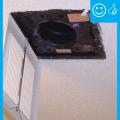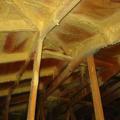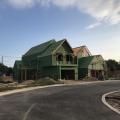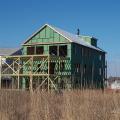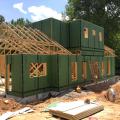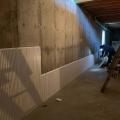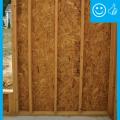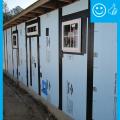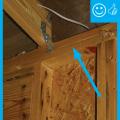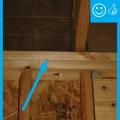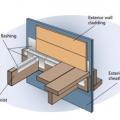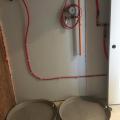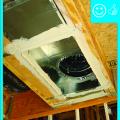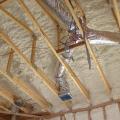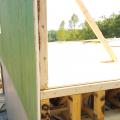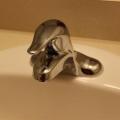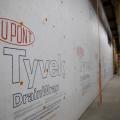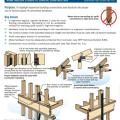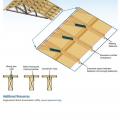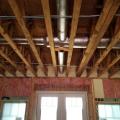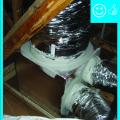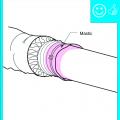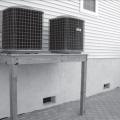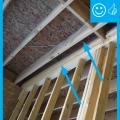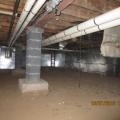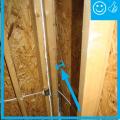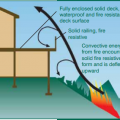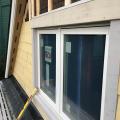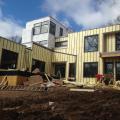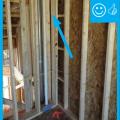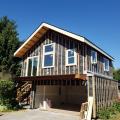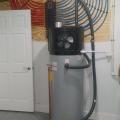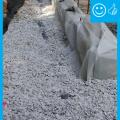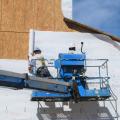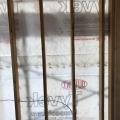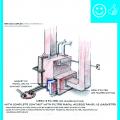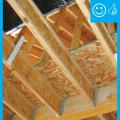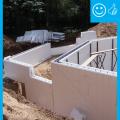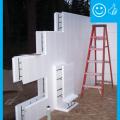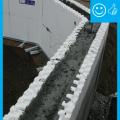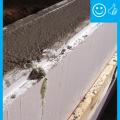Showing results 2501 - 2750 of 4973
Right - This 80-gallon heat pump water heater is ducted to pull heat from outside air drawn from the south side of the house and to exhaust cooled air outside on the north side of the house to efficiently heat water without impacting room temperatures.
Right - This air flow testing station includes a manometer to determine air flow rate for a whole house ventilation system.
Right - This builder preserved the trees around this new urban-infill home, providing excellent shading in the summer.
Right - This cedar siding is installed over furring strips which allow an air and drainage gap behind the siding.
Right - This ceiling-mounted mini whole-house fan has built-in insulated covers to reduce heat loss when the fan is not in use
Right - This concrete basement wall has exterior rigid insulation and comprehensive moisture management details.
Right - This concrete basement wall is insulated on the interior basement walls with spray foam and under the slab with rigid foam; footing details are shown.
Right - This concrete basement wall is insulated on the interior with rigid insulation; sill details are shown.
Right - This concrete basement wall is insulated on the interior with spray foam insulation; sill detail are shown.
Right - This concrete roof is properly attached and reinforced to withstand hurricane winds.
Right - This crawlspace, which is insulated on the floor, has a complete vapor barrier over the floor and up the walls that is sealed at all seams and termite inspection gap at the top of the vapor retarder.
Right - This duct penetration is properly flashed and integrated with the taped, foil-faced foam sheathing layer, which serves as the air and water barrier
Right - This ductless minisplit uses a ceiling-mounted rather than wall-mounted air handler.
Right - This enclosed parking garage in a multistory multifamily building is equipped with mechanical exhaust to remove airborne contaminants from the garage.
Right - This evaporative cooler is wall mounted to reduce leak effects and allow for ease of maintenance.
Right - This foil-faced polyisocyanurate rigid foam is installed on an existing exterior wall and the seams are taped so the rigid foam can serve as a water control layer
Right - This heat pump is located in a closet inside the home and all ducts are located within conditioned space between floors.
Right - This heated garage plenum is insulated along the bottom of the plenum space.
Right - This heated garage plenum is insulated and has an opening to access the interior, allowing for repairs and maintenance.
Right - This high-thermal-mass home uses masonry construction to naturally regulate temperatures inside the house
Right - This home was made PV ready with the installation of conduit and a dedicated electrical outlet for wiring from the roof to the circuit breaker box on the first floor.
Right - This home's windows have protective coverings that are raised to provide shade in good weather and can drop to protect the windows during high wind events.
Right - This house has key features to block heat such as such as tree shading for the west wall and roof, minimized west-facing windows, and a porch roof, floor, and wing walls creating deep architectural overhangs and fins to shade south-facing windows
Right - This kitchen exhaust duct termination is integrated aesthetically and functionally with the exterior cladding.
Right - This manufacturer's label shows a CFM higher than the requirement, increasing the likelihood that it will meet the performance level once installed.
Right - This new sealed attic has 5.5 inches (R-20) of spray foam insulation along the underside of the roof deck providing a conditioned attic space for the heating and cooling ducts.
Right - This opening in the foundation wall around this pipe was filled with wire mesh then sealed with spray foam to prevent rodent and insect entry
Right - This poured concrete basement wall is insulated on the exterior and under the slab with rigid insulation; footing details include interior and exterior footing drain pipe.
Right - This rigid insulation is correctly installed in a level layer over aggregate; the seams will be taped
Right - This roof has a low gable and is secured to the wall framing to resist wind uplift.
Right - This shared enclosed parking garage is equipped with exhaust fans to remove airborne contaminants from the garage.
Right - This shed roof is constructed with 1X4 furring strips installed over the decking and underlayment for ventilation beneath the metal roofing.
Right - This tiny house has a mono-sloped shed roof angled toward the sun to provide maximum space for solar panels.
Right - This tree has been given space around the roots to allow for proper growth and expansion of the tree over time.
Right - This unvented crawlspace is insulated along interior walls with rigid foam and air-sealed by covering the floor with vapor retarder that is sealed to the rigid foam which is taped at the seams.
Right - This unvented crawlspace is insulated along the walls and between the floor joists with 2-inch foil-faced polyisocyanurate; a termite inspection gap is visible above of the wall insulation and below the band joist.
Right - This water softener filters hard water through a mineral-collecting medium before delivering water to the main plumbing system.
Right - This waterproofing membrane on the interior of a deep soldier pile foundation with wood lagging is continuous, and penetrations through the membrane have been sealed.
Right - Triple-pane windows let in light and views while minimizing heat loss in winter and unwanted solar heat gain in summer.
Right - Two high-efficiency (12 HSPF, 26 SEER) ductless mini-split heat pumps heat and cool the home.
Right - Use flood-damage-resistant materials for decks and portions of the house below the design flood elevation.
Right - Walls and ceilings shared by the garage and living space must be air sealed and insulated.
Right - Water pressure reducing valves should be installed prior to fixture piping such as where water enters the home.
Right - Wind baffle installation will allow proper insulation depth over the top plate.
Right - Window shading is built into the south side of this home and east facing windows have been minimized to reduce heat gain from the summer sun while allowing low winter sun into the home
Right - Wood board sheathing seams are being sealed with low-expanding spray foam.
Right - Workers installed rigid foam on the floor and the sill plates of these pre-cast, pre-insulated concrete wall panels to provide a continuous layer of insulation under and around the not-yet-poured basement floor slab.
Right - XPS foam insulation is attached to the existing exterior wall with wood furring strips that serve as a nail base for the siding and are installed vertically to allow for drainage and drying behind the siding
Right - XPS rigid foam board is tightly installed against a concrete foundation wall and seams are sealed with tape prior to installing fibrous blanket insulation.
Right – Attic access hatch has been properly insulated by attaching a fiberglass batt, gasketed, and opening has blocking
Right – Deep overhangs, pergolas, and covered entryways minimize heat gain in this commercial building in the hot-dry climate.
Right – 11-inch ICFs provide R-50 of wall insulation from the footing to the roof on this cold-climate home.
Right – A 1-inch layer of XPS rigid foam covers the 2x6 wall studs and is topped by ½-inch-thick plywood sheathing, which is covered with draining house wrap and serves as a nailing surface for siding and trim.
Right – A bead of sealant will form an airtight gasket between the top plate and drywall.
Right – a booster fan was installed in this long dryer duct to increase air flow and help prevent the duct from being clogged with lint
Right – A builder of a DOE Zero Energy Ready certified home explains how a central manifold distribution system with PEX piping works.
Right – A chimney cricket is installed and flashed to direct rainwater around the chimney
Right – A contractor installs mastic in branch duct take offs to air seal the seams where they attach to the trunk duct.
Right – A deep porch provides shade and keeps sun off sliding glass doors in this Arizona home while artificial turf and xeriscaping minimize irrigation usage.
Right – A dehumidifier is installed next to the central heat pump’s air handler to pull air from the supply plenum, remove moisture, and re-introduce the air downstream in the supply plenum; this setup removes moisture efficiently.
Right – A dimpled plastic rainscreen product is installed over liquid-applied waterproofing on the exterior of the ICF foundation walls, directing water down the wall to the perimeter drain tile, thus encouraging drainage around the foundation.
Right – A dimpled-plastic rain mat was attached to the exterior below-ground walls to help minimize frost damage in cold climates.
Right – A double bead of sealant seals the seams between the SIP panel and spline.
Right – A flexible flashing product is installed around the corners of the window sill before installing the windows.
Right – A flexible tape is used to air-seal around wiring holes in the coated sheathing.
Right – A fully adhered roof membrane provides thorough water and wind protection in this mountain top location.
Right – A gap separates the two wall layers in this double-stud wall assembly allowing room for insulation to stop thermal bridging between the inner and outer wall
Right – A ground-source heat pump provides space heating and domestic hot water.
Right – A layer of sealant covers the wood-to-foam layer seams in the insulated header.
Right – A mall crew with a crane can assemble a home of structural insulated panels (SIPs) in just a few days.
Right – A mat is installed to contain radiant floor loops which distribute hot water from this home’s combi boiler.
Right – A metal flashing was installed behind the first row of siding above the windows to guide water over the trim.
Right – A non-combustible 1/8-inch mesh screen is installed on vent openings to reduce the risk of ember intrusion.
Right – A non-combustible 1/8-inch mesh screen is installed on vent openings to reduce the risk of fire from intrusion of wind-borne embers.
Right – A paint-on flashing was applied to the window frames of this ICF house before installing the windows.
Right – A protective membrane has been installed in the valleys and at the eaves of this roof before installing underlayment.
Right – A radon pipe provides a path for radon to vent to the roof rather than seeping into the home.
Right – A rain barrel is connected to the downspout of this home while a roll-up run-out on the downspout carries excess water several feet from the home during heavy rainfalls.
Right – A rigid corrugated rain screen product is installed shingle-fashion with overlapping edges behind rock veneer.
Right – A rigid rain screen product completely covers the wall behind the cladding and window framing.
Right – A simple stacked rectangular design and well-insulated and air-sealed ICF walls provide for an extremely energy-efficient structure.
Right – A strip of foam fabric is installed along the wall top plate to serve as an air sealing gasket when the drywall is installed.
Right – A sump pump with a perforated sump pit was installed in the crawlspace slab to reduce water accumulation under the slab
Right – A termite inspection gap is left at the top of the rigid foam board basement wall insulation.
Right – A transfer grille is installed high on a bedroom wall in a new-construction home
Right – A utility room provides adequate space for the home’s mechanical systems and electronic smart home monitoring equipment.
Right – A ventilating dehumidifier with a fresh air intake is tied into the central duct system of this mixed-humid climate home.
Right – Adequate space is provided near the air handler for the water lines of this ground-source heat pump.
Right – After installing the insulated concrete foundation wall panels, the builder installed underslab rigid foam, which was topped by 4 inches of crushed rock then the poured slab.
Right – Air barrier and penetrations sealed between porch attic and conditioned space
Right – Air barrier installed under staircase (picture taken from house looking into attached garage)
Right – Air vents near the top of the crawlspace wall are not used as flood vents, and flood vents are installed close to grade
Right – All electrical boxes are carefully sealed as are all top plate-to-drywall seams.
Right – All insulated sheathing boards are installed according to the manufacturer’s recommended fastening schedule and taping specifications
Right – All of the cabinet seams in this HVAC air furnace are sealed with an approved metal tape.
Right – All penetrations through the roof decking are sealed with paint-on flashing.
Right – all seams in the rigid foam were sealed with tape before installing the wire lathe for stucco.
Right – All supply ducts in this home were located in conditioned space; any return ducts that were located in the attic were insulated with closed-cell spray foam and buried in the blown-in attic insulation to prevent air leakage and heat loss.
Right – An air-to-water heat pump efficiently provides hot water for radiant floor heating.
Right – An air-to-water heat pump provides water and space heating while a heat recovery ventilator provides fresh air that is filtered by the HEPA filter.
Right – An ENERGY STAR washer and heat pump dryer save energy and money for home owners.
Right – An escutcheon is installed on this toilet tank pipe to help air seal around the pipe and prevent pest entry.
Right – An existing gable wall is reinforced with horizontal braces that butt up to the gable end wall and connect back to multiple trusses; retrofit studs make full contact with the wall and the compression blocks and are connected to the horizontal brac
Right – An HVAC contractor installs a 4-inch-thick MERV 13 filter at the intake grille of this return air vent to prevent dust, allergens, smoke, and viruses from entering the duct system.
Right – An infrared image of this home shows very little heat transfer through the exterior walls.
Right – an instructor shows a student how to cut batt insulation around wiring rather than compressing the batt behind the wiring.
Right – An instructor shows students how to caulk the top plates of interior walls.
Right – An insulated space is provided in the home’s attic to house the HVAC equipment.
Right – Angled racks are used for the photovoltaic panel installation on this flat roof.
Right – Apply sealant around penetrations through foundation walls and along foundation wall seams
Right – Appropriate use of framing members to support double windows and additional cripples for drywall purposes
Right – Attic access door has foam and rubber weatherstripping installed that remains in contact when closed.
Right – Automatic gas shutoff valve is attached to the natural gas pipeline close to the meter
Right – Backer-rod is a foam product available in various diameters that can be used to air-seal openings around doors and windows.
Right – Baffles are foamed in place between the roof joists of the vented, vaulted attic to direct air from the soffit vents up to the ridge vent.
Right – Batt insulation provides additional insulation for the home’s main duct chase.
Right – Battens are installed above the cork insulation to provide a ventilating layer between the insulation and the roof sheathing and cladding.
Right – Battens were installed above the cork insulation to provide a ventilating layer between the insulation and the roof sheathing on this “hot roof” design.
Right – Batteries can extend the hours of power the home’s PV panels can provide.
Right – Because this home is in a coastal location that may flood the crawlspace is vented and the home is constructed on metal piers.
Right – Blocking has been installed around the perimeter of this attic access to prevent insulation falling into the house
Right – Blocking is installed next to the electrical panel for future mounting of the PV inverters.
Right – Blocking was installed in the walls behind the tub for installation of grab bars.
Right – Bug screening keeps out insects and pests, allowing homeowners to enjoy the porch year round.
Right – Cantilever has been properly insulated, air sealed, and cavity has been blocked.
Right – Chase capped with rigid air barrier and duct work penetrations properly sealed
Right – Closed-cell polyurethane foam is sprayed on the underside of the roof deck to provide structural connections and seal seams in the sheathing to increase wind resistance
Right – Closed-cell spray foam insulates and air-seals the rim joist above a shared wall between the garage and living space.
Right – Closed-cell spray foam insulation in the shared wall between the garage and living space helps to air-seal the wall and protect occupants from garage pollutants.
Right – Coated OSB provides a weather-resistant air barrier for this envelope of this home.
Right – Coated OSB sheathing provides a continuous air and moisture barrier around the home.
Right – Coated sheathing is taped at all seams to serve as an exterior air barrier on the walls.
Right – Construction adhesive is applied to the rigid foam panels that will be installed on the interior basement walls.
Right – Deck flashing protects the deck-to-wall connection from water and burning embers.
Right – deeply inset entryways and overhangs provide shade to reduce solar heat entry to this building.
Right – Drip pans are installed beneath the home’s 55-gallon heat pump water heater desuperheater tank and back up electric tank water heater.
Right – Engineered open-web floor joists provide space between floors for ducting.
Right – EPA WaterSense-rated faucets reduce water usage compared to standard bathroom faucets.
Right – EPA WaterSense-rated low-flow showerheads reduce water and energy usage compared to standard showerheads.
Right – EPA WaterSense-rated showerheads, faucets, and toilets contribute to both water and energy savings.
Right – Even house wrap is installed in the factory for these modular homes where each floor is factory assembled.
Right – Every seam and nail hole in these garage-to-house walls is sealed with tape.
Right – Examples of wall stud to sill plate and foundation and wall rod connectors and brackets.
Right – Examples of wall stud to top plate and stud to rim joist framing connectors and brackets.
Right – Fan with a cleanly cut and properly sized hole has been air sealed to drywall
Right – Fiberglass batt insulation fills the walls while the floor joists above are insulated with spray foam insulation to both insulate and air seal this transition space.
Right – Flashing is installed around chimney, skylight, vents, dormers, in valleys and at eaves
Right – Flex duct is properly connected to metal duct with a duct tie and connection is mastic sealed
Right – Flex ducts are properly supported with straps that don’t pinch the insulation; closed-cell spray foam will be applied to the underside of the roof deck of this hot-humid climate home to provide an insulated attic space for the HVAC ducts.
Right – Foam gasket is installed on the surface of the framing before plywood sheathing is installed on these factory-constructed wall panels.
Right – Foil-faced insulation was added after the crawlspace was dried and sealed by diverting water runoff, sealing off crawlspace windows and vents, and adding sump pumps and exhaust fan ventilation
Right – Foundation drainage mat was installed over the waterproof membrane that covers the sealed crawlspace window
Right – Full length 2x6 nailer has been installed to allow space for insulation at wall intersection
Right – Furring strips provide a drainage and ventilation gap between the siding and the cork insulation.
Right – Furring strips provide a drainage gap between the rigid foam and the siding.
Right – Furring strips were installed to provide a 3/8-inch drainage plane over the rigid foam and under the fiber cement lap siding.
Right – Graphite enhanced EPS fills these SIP panels, providing additional insulation value.
Right – Half-inch furring strips provide a rain screen and air gap between the weather-resistant membrane and the fiber cement siding on the exterior walls of this marine-climate home.
Right – Holes were drilled into the I joists between floors to run the small-diameter HRV ducts.
Right – Home owner guidance for safe operation of fireplaces
Right – Horizontal overhangs on this house block sunlight in the summer while allowing it in during winter
Right – Hot water from this heat pump water heater is distributed efficiently to each hot water use in the home through a central manifold via PEX piping.
Right – House without gutters has waterproof liner, drain tile, and gravel bed extending more than 5 feet from foundation
Right – Housewrap was properly shingled and taped on this wall assembly which places the housewrap beneath the rigid foam sheathing; wall cavities will be filled with spray foam.
Right – HVAC furnace filter is properly installed in cabinet with gasketed cover to prevent air leakage
Right – ICFs are being installed to create a continuous air and thermal boundary
Right – ICFs are being installed to create a continuous air and thermal boundary
Right – ICFs are being installed to create a continuous air and thermal boundary
Right – ICFs are being installed to create a continuous air and thermal boundary
